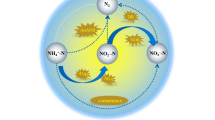Abstract
Aerobic sludge granules are compact, strong microbial aggregates that have excellent settling ability and capability to efficiently treat high-strength and toxic wastewaters. Aerobic granules disintegrate under high organic loading rates (OLR). This study cultivated aerobic granules using acetate as the sole carbon and energy source in three identical sequencing batch reactors operated under OLR of 9–21.3 kg chemical oxygen demand (COD) m−3 day−1. The cultivated granules removed 94–96% of fed COD at OLR up to 9–19.5 kg COD m−3 day−1, and disintegrated at OLR of 21.3 kg COD m−3 day−1. Most tested isolates did not grow in the medium at >3,000 mg COD l−1; additionally, these strains lost capability for auto-aggregation and protein or polysaccharide productivity. This critical COD regime correlates strongly with the OLR range in which granules started disintegrating. Reduced protein quantity secreted by isolates was associated with the noted poor granule integrity under high OLR. This work identified a potential cause of biological nature for aerobic granules breakdown.





Similar content being viewed by others
References
Adav SS, Chen MY, Lee DJ, Ren NQ (2007a) Degradation of phenol by aerobic granules and isolated yeast Candida tropicalis. Biotechnol Bioeng 96:844–852
Adav SS, Lee DJ, Ren NQ (2007b) Biodegradation of pyridine using aerobic granules in the presence of phenol. Water Res 41:2903–2910
Adav SS, Lee DJ, Show KY, Tay JH (2008a) Granular sludge: recent advances. Biotechnol Adv 26:411–423
Adav SS, Lee DJ, Lai JY (2008b) Intergeneric coaggregation of strains isolated from phenol degrading aerobic granules. Appl Microbiol Biotechnol 79:657–661
Adav SS, Lee DJ, Wang AJ, Ren NQ (2009) Functional consortium for hydrogen production from cellobiose: concentration-to-extinction approach. Bioresour Technol 100:3465–3470
APHA (1998) Standard methods for the examination of water and wastewater, 20th edn. American Public Health Association, Washington
Arrojo B, Mosquera-Corral A, Garrido JM, Mendez R (2004) Aerobic granulation with industrial wastewater in sequencing batch reactors. Water Res 38:3389–3399
Bossier P, Vertraete W (1996) Triggers for microbial aggregation in activated sludge? Appl Microbiol Biotechnol 45:1–6
Chen Y, Jiang WJ, Liang DT, Tay JH (2008) Aerobic granulation under the combined hydraulic and loading selection pressures. Bioresour Technol 99:7444–7449
de Kreuk MK, Pronk M, van Loosdrecht MCM (2005) Formation of aerobic granules and conversion processes in an aerobic granular sludge reactor at moderate and low temperatures. Water Res 39:4476–4484
de Kreuk MK, Kishida N, van Loosdrecht MCM (2007) Aerobic granular sludge—state of the art. Water Sci Technol 55:75–81
Frolund B, Keiding K, Nielsen PH (1995) Enzymatic activity in the activated sludge flocs matrix. Appl Microbiol Biotechnol 43:755–761
Gaudy AF (1962) Colorimetric determination of protein and carbohydrate. Ind Water Wastes 7:17–22
Kim IS, Kim SM, Jang A (2008) Characterization of aerobic granules by microbial density at different COD loading rates. Bioresour Technol 99:18–25
Li AJ, Yang SF, Li XY, Gu JD (2008) Microbial population dynamics during aerobic sludge granulation at different organic loading rates. Water Res 42:3553–3560
Liu Y, Liu QS (2006) Causes and control of filamentous growth in aerobic granular sludge sequencing batch reactors. Biotechnol Adv 24:115–127
Liu Y, Tay JH (2004) State of the art of biogranulation technology for wastewater treatment. Biotechnol Adv 22:533–563
Maximova N, Dahl O (2006) Environmental implications of aggregation phenomena: current understanding. Curr Opin Colloid Interf Sci 11:246–266
McSwain BS, Irvine RL, Wilderer PA (2004) The effect of intermittent feeding on aerobic granule structure. Water Sci Technol 49:19–25
Morgenroth E, Sherden T, van Loosdrecht MCM, Heijnen JJ, Wilderer PA (1997) Aerobic granular sludge in a sequencing batch reactor. Water Res 31:3191–3194
Moy BY, Tay JH, Toh SK, Liu Y, Tay STL (2002) High organic loading influences the physical characteristics of aerobic sludge granules. Lett Appl Microbiol 34:407–412
Nielsen PH, Frolund B, Keiding K (1996) Changes in the composition of extracellular polymeric substances in activated sludge during anaerobic storage. Appl Microbiol Biotechnol 44:823–830
Tay JH, Liu QS, Liu Y (2001) Microscopic observation of aerobic granulation in sequential aerobic sludge blanket reactor. J Appl Microbiol 91:168–175
Tay JH, Liu QS, Liu Y (2002) Aerobic granulation in sequential sludge blanket reactor. Water Sci Technol 46:41–48
Tay JH, Pan S, He Y, Tay STL (2004) Effect of organic loading rate on aerobic granulation. I: Reactor performance. J Environ Eng 130:1094–1101
Thanh BX, Visvanathan C, Ben Aim R (2008) Characterization of aerobic granular sludge at various organic loading rates. Process Biochem. doi:10.1016/j.procbio.2008.10.018
Yang SF, Liu Y, Tay JH (2003) A novel granular sludge sequencing batch reactor for removal of organic and nitrogen from wastewater. J Biotechnol 106:77–86
Zheng YM, Yu HQ, Liu SH, Liu XZ (2006) Formation and instability of aerobic granules under high organic loading conditions. Chemosphere 63:1791–1800
Acknowledgement
This project is financially supported by the State Key Laboratory of Water Resource and Environment (SKLWRE), Harbin Institute of Technology, China.
Author information
Authors and Affiliations
Corresponding author
Rights and permissions
About this article
Cite this article
Adav, S.S., Lee, DJ. & Lai, JY. Potential cause of aerobic granular sludge breakdown at high organic loading rates. Appl Microbiol Biotechnol 85, 1601–1610 (2010). https://doi.org/10.1007/s00253-009-2317-9
Received:
Revised:
Accepted:
Published:
Issue Date:
DOI: https://doi.org/10.1007/s00253-009-2317-9




